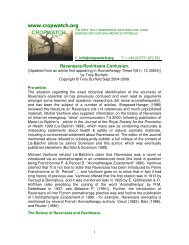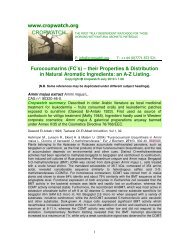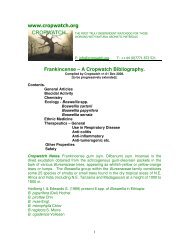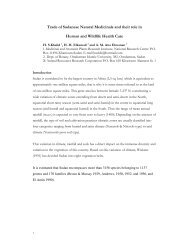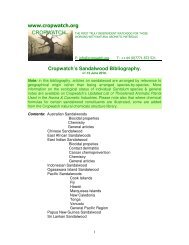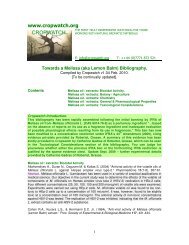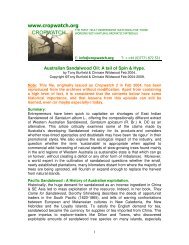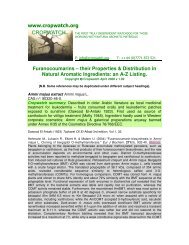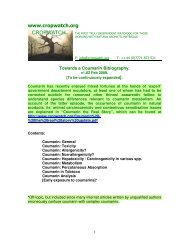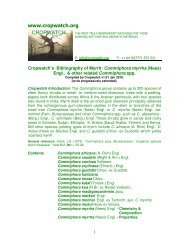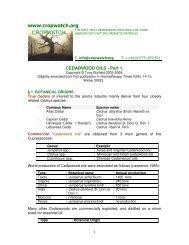The Adulteration Of Essential Oils - Cropwatch
The Adulteration Of Essential Oils - Cropwatch
The Adulteration Of Essential Oils - Cropwatch
Create successful ePaper yourself
Turn your PDF publications into a flip-book with our unique Google optimized e-Paper software.
GC-MS<br />
GC-FTIR (Fourier transform Infra-Red)<br />
GC- 13 C NMR (Nuclear Magnetic Resonance -see Kubeczka & Formáček<br />
2002)<br />
HPLC-MS.<br />
Whilst these techniques are undoubtedly useful, the cost of trained operator<br />
time and the necessary allocation of sophisticated & expensive hardware for<br />
the time-consuming methodology and number crunching capabilities, all for<br />
what is essentially a basic QC task asking a question “is this material genuine<br />
or not?”, is often seen as inappropriate by aroma company management.<br />
Less capital intensive techniques therefore might be deemed more practical<br />
and appropriate, and nowadays, it might be considered that minimum<br />
equipment (“entry level”) for oil authentication work would be a GC/MS facility<br />
and access to chiral chromatography techniques.<br />
Thin layer chromatography (TLC). This technique requires a less capitalintensive<br />
investment, and for example is a requirement for essential oil testing<br />
(in conjunction with a battery of other tests), in the BP monograph (2007) on<br />
Citronella oil (Cymbopogon winterianus), amongst others. <strong>The</strong> monograph<br />
requires identification of the oil by TLC and gas chromatography (reference<br />
chromatogram with identified compounds is supplied, the test oil results must<br />
be within prescribed limits), as well as requiring prescribed physio-chemical<br />
testing.<br />
In another area, TLC has been used to identify the geographical origins of<br />
olibanum resins (Harefield 1984).<br />
Fingerprints.<br />
A slightly older review of the value of “fingerprints” in e.o. analysis is given by<br />
Lamparsky (1987), the subject of which centres on: pattern recognition of GC<br />
traces of e.o.’s, examples of character compounds (which Lamparsky terms<br />
impact compounds) and unique components of certain oils, as well as the<br />
enantiomeric analysis technique (see below). Nowadays, GC analysts have<br />
the additional resource of commercial available MS libraries, which compare<br />
the spectrum of each compound detected with a library of reference spectra,<br />
identifying the closest matches, and giving a confidence level estimation of<br />
each tentative identification.<br />
Marker Compounds.<br />
Many oils have unique or unusual marker compounds, which can be used as<br />
standards of authentication, such that some essential oil customers will only<br />
purchase oils conform to certain stipulated limits for these marker compounds.<br />
An introduction to this topic is given by Teissaire (1987). <strong>The</strong> table below<br />
gives a few analytical hints:<br />
<strong>Essential</strong> Oil Examine for: Indications<br />
Anise oil γ-himalchene, pseudoisoeugenyl 2methylbutyrate<br />
and foeniculum.<br />
12<br />
To distinguish between<br />
Pimpinalla anisum and





